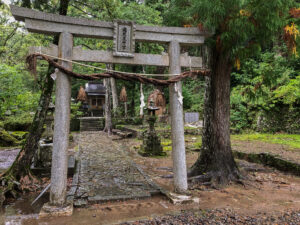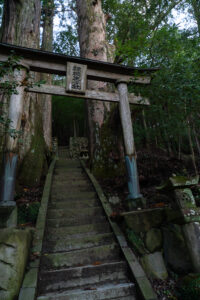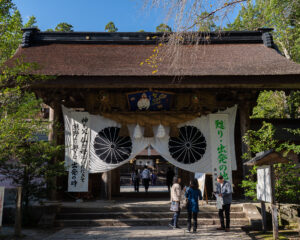In mid October, 2020, I made a 2-day & 39-kilometer-long pilgrimage in Kumano and paid visits to the Kumano Sanzan (the three Grand Shrines in Kumano). Did my inner self get purified?
The pilgrimage routes bound for the Kumano Sanzan Grand Shrines in the south of the Kii Peninsula are called the Kumano Kodo. “Kumano” and “Kodo” means “very deep and richly wooded mountains and valleys” and “ancient routes”, respectively, and Kumano has been regarded as a sacred place of pilgrimage where the Kumano Sanzan Grand Shrines were established. Over centuries, people in all levels including ex-emperors and courtiers in Kyoto made long and arduous pilgrimages to the Kumano Sanzan.
My 2-day-long pilgrimage was made along the Nakahechi route, one of the Kumano Kodo, starting at the Takijiri Oji Shrine and ending at the Kumano Hongu Grand Shrine (one of the Kumano Sanzan). On Day 3, I paid visits to the Kumano Nachi Grand Shrine and the Kumano Hayatama Grand Shrine to perfect my pilgrimage. The Nakahechi route was established in the beginning of the 10th century and historically travelled by many Imperial family members from Kyoto. For one, ex-emperor Goshirakawa (1127~1192) made his pilgrimage from Kyoto to the Kumano Sanzan, to my surprise, 33 times!
In the morning of October 23, I left a hotel in the Kii Tanabe City and reached the Takijiri Ohji Shrine which represents an entry into the sacred area of Kumano. A route from the Takijiri Oji Shrine to the Takahara Kumano Shrine was a mountain path and surrounded by deep forests of evergreen oak. For its serene and solemn ambiance, the route has been regarded as “the womb of Kumano Gongen (the incarnation of Buddha in the form of a Shinto deity)”.
 Takijiri Oji Shrine
Takijiri Oji Shrine  Takahara
Takahara
Along the Nakahechi pilgrimage route, there are many Oji (shrines), Buddhist statues and monuments to worship. Out of them, the Gyuba Doji statue is one of the most popular. It can be reached after visiting five Oji or shrines in six hours on Day 1. As shown in the photo (below), a small child (doji) is riding an ox and a horse (gyuba) which has made a mascot of the Nakahechi route. It is said that the statue is modeled after Kazan Ho-oh (ex-emperor with a Buddhist name) who made a Nakahechi pilgrimage.
 Gyuba Doji
Gyuba Doji  Sunset in Kumano
Sunset in Kumano
After staying at a small inn, my Day 2 started with a visit to the Tsugizakura Oji Shrine and ended at the Kumano Hongu Grand Shrine after waking of 21 kilometers. It is a pity that about half the Day 2 route has been damaged by typhoons in past years so I needed to pass detour paths and missed several Oji shrines and yet the route was so great to feel the nature of Kumano. I sincerely wish the original route be restored before long so that pilgrims can walk the whole original path.
 Tugizakura Oji
Tugizakura Oji  Nakahechi on Day 2
Nakahechi on Day 2
The Kumano Hongu Grand Shrine is one of the Kumano Sanzan and all the Kumano Kodo routes lead to this grand shrine. The original shrine structures were said to be built in the 3rd century. Its pavilions are so magnificent and represents an outstanding example of the Japanese old Shrine architecture. The roofs are thatched with cypress bark and the use of natural materials matches the natural surroundings, creating serene and solemn atmosphere.
 Kumano Hongu
Kumano Hongu  Kumano Hongu
Kumano Hongu
In 2004, three sacred sites (the Kuman Sanzan, Koya-san, Yoshino~Ohmine) and the Kumano Kodo pilgrimage routes to connect them were registered by UNESCO as World Cultural Heritage Sites. Why don’t you plan to extend your legs to the Kumano after visiting Kyoto and Nara so that you feel the spiritual origins of Japan?
By Jin Shibata
Email jin.shibata@i3ws.co.jp

Comment